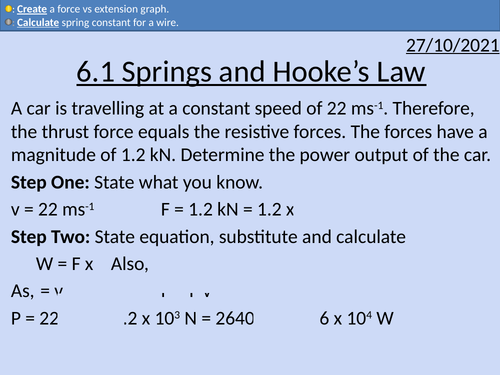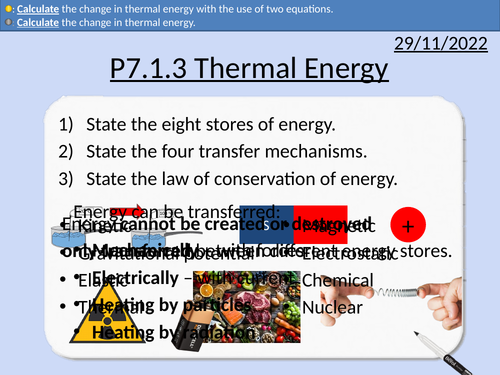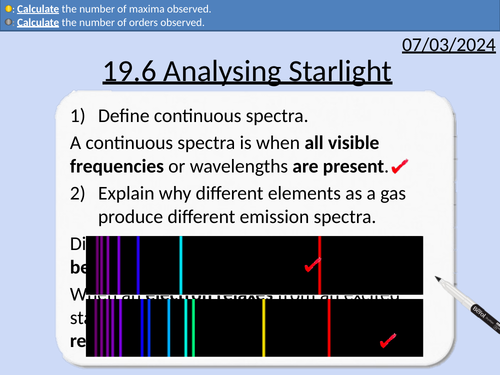496Uploads
163k+Views
70k+Downloads
Physics

OCR AS level Physics: Springs and Hooke's Law
OCR AS level Physics: Springs and Hooke’s Law is a part of the Module 3: Materials.
Presentation come with worked examples, solutions and homeworks.

OCR AS level Physics: Stationary Waves in Air Columns
OCR AS level Physics: Stationary Waves in Air Columns is a part of the Module 4: Electrons, Waves, and Photons. PowerPoint with worked examples and homework.

OCR AS level Physics: Harmonics
OCR AS level Physics: Harmonics is a part of the Module 4: Electrons, Waves, and Photons. PowerPoint with worked examples and homework.

GCSE Physics: Types of Waves
This presentation covers OCR Gateway Physics 9-1 P5.1.1a WaTypes of wave. Includes student activities and full worked answers.
Definition of a wave
Mechanical waves
Electromagnetic waves
Transverse waves
Longitudinal waves
Bundle

GCSE OCR Physics P5.1 Wave Behaviour
Resources for P5.1 GCSE OCR Physics Gateway 9-1 Triple and Combined (Higher and Foundation) is covered in this material.
Each lesson includes student activities and full worked answers.
Includes:
Definition of a wave
Mechanical waves
Electromagnetic waves
Transverse waves
Longitudinal waves
Amplitude
Wavelength
Frequency
Time period
Calculating frequency and equation
Relationship between frequency and wavelength when speed is constant.
Calculating time period from frequency with equations
The speed equation
Measuring distance and time
Simple experiment for the speed of sound
Improving experiments
Echoes
Speed of sound experiment with microphones and oscilloscope.
Ray diagrams
Absorption, reflection and transmission
Sonar
Ultrasound
Rearranging equation
Refraction
Relationship between wave speed and wavelength
Structure of the ear.
Frequency range of human hearing.
Explanation of the limited frequency range of humans.
Explanation for hearing deteriorating with age.

OCR AS Physics: Internal Resistance
OCR AS Physics: Internal Resistance is a part of the Module 4: Electrons, Waves, and Photons. PowerPoint with worked examples and homework.
Find lost volts and terminal potential difference from a source of emf
Calculate internal resistance of a cell
Calculate internal resistance of a cell with a graph
Calculate EMF of a source

GCSE Physics: Transformers
This lesson presentations covers OCR Gateway Physics 9-1 P4.2.5 Transformers.
Examples of transformers in everyday life
Structure of a transformer Step-up and Step-down transformers
Transformer equation and rearranging equations.
Worked Examples and Student problems with worked solutions.
Explanation for use of step-up transformers - efficiency

GCSE Physics: Nuclear Equations
This presentation covers OCR Gateway Physics 9-1 P6.1.3 Nuclear Equations
All presentations come with student activities and worked solutions.
Nuclear Notation - mass number and atomic number
Nuclear equations for emissions of:
Alpha radiation
Beta radiation
Gamma radiation

OCR A level Physics: Internal Energy
OCR A level Physics: Internal Energy is a part of the Module 5: Newtonian World and Astrophysics. The PowerPoint presentation includes worked examples, solutions and a homework.

GCSE Physics: Alpha, Beta, Gamma Radiation
This presentation covers OCR Gateway Physics 9-1 P6.1.2 Alpha, Beta, Gamma Radiation.
All presentations come with student activities and worked solutions.
Types of radiation - alpha, beta, gamma, and neutrons
Ions and Atoms
Ionising Radiation
Geiger counter
Range and penetrative power
Precautions using radiation sources
Exam question with solution
Bundle

GCSE OCR Physics: P7.1 Energy and Forces
All resources for P7.1 Work Done GCSE OCR Physics Gateway 9-1. Triple and combined (Higher and Foundation) is covered in this material.
Energy Stores and Energy Transfers
Work Done and Kinetic Energy
Work Done, Kinetic Energy and Thermal Energy
Work Done and Spring Energy
Gravitational Energy
Kinetic Energy
Kinetic and Gravitational Energy
Gravitational and Spring Energy
Gravitational Force and Energy

GCSE Physics: Work Done, Kinetic and Thermal Energy
This presentation covers OCR Gateway Physics 9-1 P7.1.3 Work Done, Kinetic and Thermal Energy
Comes complete with students activities and fully worked solutions.
Energy transfers to thermal store.
Thermal energy, equation, and specific heat capacity.
Work done equation and kinetic energy equation.
Rearranging equations.
Applying equations.
Student questions with fully worked solutions.

GCSE Physics: Electrical Heating
This presentation covers OCR Gateway Physics 9-1 P7.2.3 Electrical Heating Transfers. All presentations come with student activities and worked solutions.
Walls and Insulation
Thermal energy dissipation
Reducing thermal energy dissipation with lubrication and insulation
Heating substances and state changes
Work done = Power x Time
Change in thermal energy = Mass x Specific Heat Capacity x Change in temperature
Thermal energy for state change = Mass x Specific latent heat
Bundle

GCSE OCR Physics: P8.1 Physics on the move
All resources for P8.1 Physics on the move GCSE OCR Physics Gateway 9-1. Triple and combined (Higher and Foundation) is covered in this material.
Average speeds of walking, running, cycling, cars, trains, wind, sound, and light.
The speed equation
The acceleration equation
Explaining average speed camera
Explaining instantaneous speed camera
Estimating everyday accelerations
Calculating speed from rotation speed and circumference of wheels
Converting from miles per hour to meters per second
Reaction time definition
Factors that increase reaction time
Simple reaction time experiment
Thinking distance
Rearranging equations
Speed equation
(Final velocity)2 – (Initial velocity)2 = 2 x Acceleration x Distance
v2 – u2 = 2 a s
Factors affecting braking distance
Total stopping distances
Calculating area of a velocity-time graph for displacement (distance traveled).
Rearranging equations
MOT testing
Large accelerations produce large forces.
Values of g that cause severe injury or death
Road Safety
Newton’s First Law and seat belts
Crumple zones
Force = Mass x Acceleration
Acceleration = Change in velocity /Time taken
Estimating speed, accelerations and forces involved in large accelerations for everyday road transport.
Bundle

GCSE OCR Physics: P8.2 Powering Earth
All resources for P8.2 Powering Earth GCSE OCR Physics Gateway 9-1. Triple and combined (Higher and Foundation) is covered in this material.
Types of different energy sources
Renewable and non-renewable definitions
Different uses of energy sources - transport, heating, and generating electricity
Advantages and disadvantages of different energy sources
Fossil fuels – oil, coal, and natural gas.
Nuclear fuel – Uranium
Biofuels – wood, biodiesel, and biogas.
The sun - solar (PV) panels and solar heating panels
Tides
Waves
Hydroelectricity
Wind
Geothermal
How use of energy resources have changed over time. (Biofuels, Fossil Fuels, Nuclear, Renewable).
How energy use has increased (increase population and development of technology)
Explain patterns and trends in the use of energy resources.
Fossil fuels are finite and will run out at current consumption levels.
Structure of the National Grid
Step-up and Step-down transformers
How transformers increase the efficiency of the National Grid
Number of turns and potential difference
Current and potential difference in primary and secondary coils
Domestic Electrical Supply being 230 V, AC at 50 Hz.
Direct potential difference and alternating potential difference.
Reasons for insulation on wires.
Potential Difference between different conductors.
Function of the earth conductor.
Double insulation and no earth wire.
Reasons the live wire is dangerous.
Reasons why live to earth is dangerous.

GCSE Physics: Sounds in Solids and the Ear
This presentation covers OCR Gateway Physics 9-1 P5.1.4 Sound in Solids and the Ear. Includes student activities and full worked answers.
Structure of the ear.
Frequency range of human hearing.
Explanation of the limited frequency range of humans.
Explanation for hearing deteriorating with age.

GCSE Physics: Imaging with Electromagnetic Waves
This presentation covers OCR Gateway Physics 9-1 P5.2.3 Imaging with Electromagnetic waves. Includes student activities and full worked answers.
Careers: Medical Physicist
X-rays
CT scans
Gamma imaging
Thermogram
Magnetic Resonance Imaging
Precautions for using ionising radiation

OCR A level Physics: Analysing Starlight
OCR A level Physics: 19.6 Analysing Starlight
Module 5 Newtonian World and Astrophysics
This PowerPoint is a whole lesson included with student activities, animated answers, homework questions with answers provided.
This lesson covers:
Electromagnetic interference
Double slit experiment
Path and phase difference
Diffraction grating
The grating equation
Lines per millimeter to grating spacing
Maximum order, n
Maximum number of maxima

OCR A level Physics: Hubble’s Law
OCR A level Physics: 20.3 Hubble’s Law
Module 5 Newtonian World and Astrophysics
This PowerPoint is a whole lesson included with student activities, animated answers, homework questions with answers provided.
This lesson covers:
The Cosmological Principle
Hubble’s Observations
Hubble’s Law
Hubble’s constant and the gradient of a graph
Converting between km s-1 Mpc-1 into s-1
The expanding Universe model.

OCR AS level Physics: Resistance
OCR AS Physics A: Resistance is a part of the Module 4: Electrons, Waves, and Photons. PowerPoint with worked examples and homework.
Definition of an ohm.
Temperature and resistance for metallic conductors (wires)
The ohm in base SI units
I against V graphs and resistance




















